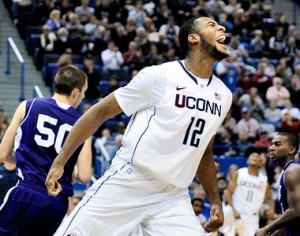The hardest thing to do is evaluate, compare, and predict how a player is going to pan-out at the next level. It’s especially difficult when the player extremely under-performed in his one season before turning pro. That’s the case with Connecticut’s Andre Drummond.
Here’s my take.Drummond should be finishing up his senior year in high school, but graduated early and enrolled in classes last fall at Connecticut. Drummond has been projected to the “next” Dwight Howard. On Thursday, Drummond said that he is declaring for the NBA June draft after a disappointing freshman season at UConn. It was a freshman season that consisted of a lot of ups-and-downs that included some big performances, but included more disappointing performances. In the NCAA tournament, Drummond was absolutely exposed by Iowa State’s Royce White. Drummond finished that game with two points, three rebounds and four blocks, but he fouled out in 26 minutes. White made Drummond look slow, un-athletic, and like he has never played basketball before. At times this season, Drummond looked confused, lost, and unsure of himself. Well, let’s be honest, UConn’s entire season was a loss and confusing, and now their future is unsure, as the program is currently falling apart around Jim Calhoun. I read an interesting tweet this morning from ESPN’s Chad Ford, saying “Is Andre Drummond the next Dwight Howard or the next Kwame Brown?”
Let’s analyze this a bit. Drummond is bigger than Howard when Howard entered the league; he shoots free-throws about as well as Howard (29.5%), and has no game outside of the paint whatsoever. Call me a “Dwight Howard hater”, but I checked a stat and if Howard would make 70% of his free-throws, he would average 23 ppg instead of 21 ppg. I like Drummond’s length and athleticism. He isn’t quite 7-ft (6’11), but he plays like he is a 7-footer. I also like his shot-blocking ability. If look at current NBA rosters, there are only two players that have the size and athleticism that Drummond possesses while not being 7-ft at the center position. Those two players are DeAndre Jordan and Howard. Someone please tell me how someone with the last name Jordan, first name not Michael, gets $11 million a year to play 27 mpg and average 7.5 ppg and 8.4 rpg? Are those numbers worthy of $11 mil a year?
Drummond’s offensive game is very raw. A lot of his points came against teams who didn’t possess the type of height, athleticism, or defense that Drummond will face at the next level. Nevertheless, Drummond has some decent post moves, but he scored a lot of his points on offensive rebounds. He looks uncoordinated at times and his footwork is not superb, yet. He was at the top of most draft boards when the college season began, but he only averaged 10 ppg as a freshman. So it’s clear that he is still learning the game on the offensive end.
What Drummond lacks offensively, he makes up for some of it on defense. Drummond showed great shot-blocking ability (2.7 blkpg) in his only season at UConn. He also is a very good defensive rebounder (4.2 drpg). As the Los Angeles Clippers showed with [DeAndre] Jordan, some teams are willing to pay millions for rim-protectors.
But what separates him from Anthony Davis? The answer is simple: their motors. Davis is always playing fast, while Drummond (like I mentioned earlier) looks lost and unsure of what to do. Davis’ will to be great is what makes him a clear-cut no. 1 pick. But you never know. Maybe Davis doesn’t pan-out the way scouts had projected and maybe Drummond exceeds Davis as a better pro. On my draft board I have Drummond rated as the 15th best prospect. But I will probably move him up due to the “potential” that he possesses somewhere, deep inside of him.
I think the comparison to Howard is absurd. I don’t he will be anywhere near Howard defensively. Howard changes games and wins games. Davis is closer to Howard defensively than Drummond.
As far as I am concerned, right now, Drummond might be the next Jordan.
I mean DeAndre Jordan.
